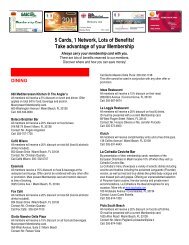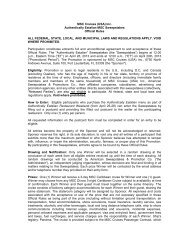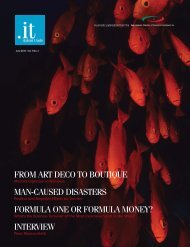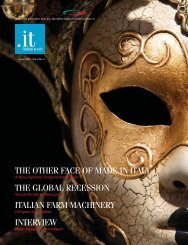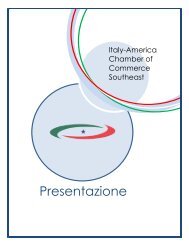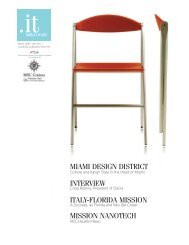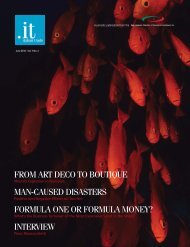italian fashion defines luxury - Italy-America Chamber of Commerce ...
italian fashion defines luxury - Italy-America Chamber of Commerce ...
italian fashion defines luxury - Italy-America Chamber of Commerce ...
Create successful ePaper yourself
Turn your PDF publications into a flip-book with our unique Google optimized e-Paper software.
Italian Fashion Defines Luxury:<br />
FOCuS<br />
Quality, Craftsmanship and Culture<br />
By Christopher P. Ramey, Chairman, The Luxury Marketing Council Florida<br />
The thread between <strong>luxury</strong>, <strong>fashion</strong> and <strong>Italy</strong> is indelibly intertwined. Luxury<br />
products are defined as those that are so distinguished by the quality <strong>of</strong> the art<br />
and science lavished on them, and/or so distinguished by their inherent value and<br />
in such short supply that they command a premium price. Luxury has been with us<br />
since the earliest <strong>of</strong> times. But, Italians perfected <strong>luxury</strong> as we know it.<br />
Authenticity is a pillar <strong>of</strong> <strong>luxury</strong> in <strong>Italy</strong>. It’s important that Italian <strong>luxury</strong> products<br />
are manufactured in <strong>Italy</strong>. True <strong>luxury</strong> brands don’t outsource to Asia. Great pride<br />
is taken by the family whose name adorns that product; <strong>of</strong>ten for a long time. For<br />
example, the Beretta family began making barrels 484 years ago in 1526. It’s now<br />
evolved into one <strong>of</strong> the preeminent brands in the <strong>fashion</strong> and firearms industries,<br />
and it’s still owned and managed by a Beretta family member.<br />
Fast forward to 2010 and the most coveted <strong>luxury</strong> brands in the world are Italian.<br />
According to AC Nielsen, and highlighted by Bernstein Research in their September<br />
2009 report on LVMH, the most coveted <strong>luxury</strong> and <strong>fashion</strong> brand in the world is<br />
Gucci. In fact, half the brands in the top 12 are Italian; they include Gucci, Giorgio<br />
Armani, Versace, Prada, and Diesel. Valentino, Emporio Armani, Ferragamo, Fendi,<br />
and Bottega Veneta also earned a listing in the top 24.<br />
Although the numbers are not yet out, global <strong>luxury</strong> sales are expected to have<br />
dropped 13% in 2009. In the <strong>America</strong>s, 90% United States, sales are expected<br />
to have dropped 21%. The drop in sales and projected slow recovery has Italian<br />
manufacturers focusing on China. China’s retail sales are expected to grow 16 –<br />
18% in 2010. White collar working women, aged 22 – 32 are driving the growth.<br />
They <strong>of</strong>ten still live at home and their savings rate is effectively zero. The attraction<br />
is exacerbated by revolving credit cards that are growing at an amazing 30% yearly<br />
rate. This demographic fits the <strong>fashion</strong> industry perfectly.<br />
Mercedes-Benz and BMW are experiencing similar positive results in China; beating<br />
last year’s numbers three fold. The growth <strong>of</strong> <strong>luxury</strong> in China will continue to<br />
compensate for the declines throughout most <strong>of</strong> the rest <strong>of</strong> the world.<br />
Despite the ubiquity <strong>of</strong> <strong>luxury</strong> brands in <strong>America</strong>, <strong>America</strong>ns purchase <strong>luxury</strong><br />
products at a ratio far below Europeans. According to the Merrill Lynch Capgemini<br />
Il filo che collega lusso, moda ed Italia é indelebilmente<br />
intrecciato. I prodotti di lusso sono definiti come quelli che si<br />
distinguono per la qualitá dell’arte e della scienza di cui sono<br />
pervasi e/o per il loro intrinseco valore, ed in tale scarsitá<br />
d’<strong>of</strong>ferta essi richiedono un premio di prezzo. Il concetto di<br />
lusso é esistito fin dai tempi piú antichi. Ció nonostante, gli<br />
<strong>italian</strong>i sono stati coloro che lo hanno perfezionato e lo hanno<br />
portato ad essere ció che oggi noi conosciamo.<br />
L’autenticitá é uno dei pilastri del lusso in Italia. É importante<br />
che i prodotti di lusso siano fabbricati in Italia. I veri marchi<br />
del lusso non esternalizzano la produzione nei Paesi Asiatici. La<br />
famiglia che puó identificare un prodotto con il proprio nome<br />
lo ritiene un grande motivo d’orgoglio, soprattutto quando<br />
il riconoscimento é di lungo tempo. Ad esempio, la famiglia<br />
Beretta inizió a produrre canne per armi da fuoco ben 484 anni<br />
fa, nel 1526. Oggi rappresenta uno dei piú importanti marchi<br />
nel settore della moda e delle armi da fuoco, ed é ancora di<br />
proprietá di un membro della famiglia Beretta.<br />
Facendo un passo avanti ad oggi, i marchi del lusso piú ambiti<br />
al mondo sono ancora <strong>italian</strong>i. Secondo AC Nielsen, e come<br />
evidenzia la Bernstein Research nel suo report pubblicato nel<br />
settembre del 2009 su LVMH, il marchio del lusso e della moda<br />
piú desiderato al mondo é Gucci. Infatti, circa la metá dei 12<br />
marchi piú ambiti sono <strong>italian</strong>i: questi includono Gucci, Giorgio<br />
Armani, Versace, Prada e Diesel. Valentino, Emporio Armani,<br />
Ferragamo, Fendi e Bottega Veneta si classificano tra i primi 24.<br />
Il mercato del lusso in evoluzione<br />
Sebbene i numeri non siano ancora stati pubblicati, si prevede<br />
che le vendite globali relative al settore del lusso siano diminuite<br />
di circa il 13% nel 2009. Nel continente americano, dove gli USA<br />
contano per il 90%, il declino é previsto essere addirittura del<br />
21%. Il calo nelle vendite e la prospettiva di una lenta ripresa<br />
ha portato i produttori <strong>italian</strong>i ad interessarsi al mercato cinese.<br />
Si prevede che le vendite al dettaglio in Cina crescano dal 16 al<br />
18% nel 2010. Le donne d’affari di alto livello, di etá compresa<br />
tra i 22 ed i 32 anni, guidano la crescita. Nella maggior parte<br />
dei casi, queste vivono ancora in famiglia ed i loro risparmi<br />
sono pressappoco pari a zero. L’attrattiva di questi prodotti é<br />
poi esacerbata dalle carte di credito a pagamento rateale, il cui<br />
utilizzo sta crescendo ad un incredibile tasso del 30% annuo.<br />
Questi dati demografici sono ideali per il settore della moda.<br />
Mercedes-Benz e BMW stanno sperimentando dei risultati<br />
.6



